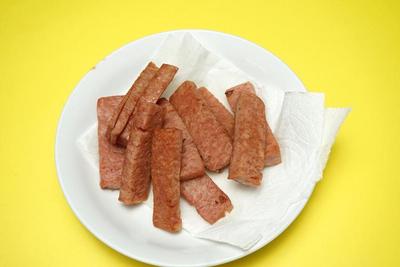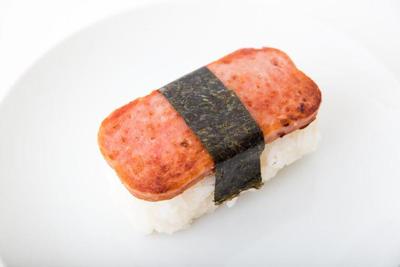🥩 Can Dogs Eat Spam? - The Original
There’s more than one way to cook and eat spam, but is it actually good for animals? Lets find out.
 It looks gross, even on a nice salad board 😷
It looks gross, even on a nice salad board 😷
Summary
Spam is a popular food item in the United States and UK, It’s also one of the most controversial foods available to pet owners, many people are concerned about whether or not it can be safely fed to their pets. The truth is that there have been no documented cases of canine poisoning from eating this mixed meat. However, we strong recommend not feeding this to your dog, it contains a ton of sodium, fat and other chemicals which we’ll discuss below.
What is it
Spam has been around since World War II when American soldiers were given a ration of meat that was too tough to eat but still had some nutritional value. The name “spam” comes from the fact that it looked like an unappetizing piece of muscle tissue, that’s pretty horrible if you ask me 😟.
Ingredients
It is made up mostly of either ground-up beef or ground pork or chicken mixed with salt 🧂, spices, sugar and other ingredients such as sodium nitrite and potatoes starch. Today, most people think of canned or frozen ham as being similar in taste to spiced sausage. However, there are many different types of processed meats available today including hotdogs, bologna, salami, pepperoni, bacon.
Is it bad?
Although Spam isn’t considered bad, it certainly raises questions when compared to healthier alternatives. For example, canned tuna contains significantly fewer calories and almost twice as much protein as Spam. Canned salmon provides similar benefits but without the added cholesterol found in this product. Other options include egg whites, lean ground meat, chicken breasts, tofu, beans,nuts, seeds, whole grains, fruits, vegetables, and herbs.

Dangers with meat byproducts
Meat products aren’t always safe for consumption by humans or animals. Some types of processed meat products — including sausages, jerky, salami, bologna, pepperoni, corned beef, and others — contain substances called mycotoxins. These mycotoxins are toxic compounds produced by molds that grow naturally on certain kinds of animal feed. They can enter the bloodstream through cuts or wounds, causing health issues ranging from headaches to vomiting to diarrhea.
Mycotoxin contamination can occur during the processing, storage, transportation, and handling of these products.
Salt poisoning
The first thing you need to know about Spam is that it contains an excessive amount of sodium. This means that feeding your dog large quantities of Spam could lead to serious problems with his kidneys or heart (en.wikipedia.org)!
Sodium is essential for maintaining proper blood pressure levels, which helps keep organs functioning properly. If you give your dog more than what they needs, however, excess sodium will build up inside them. When too much salt builds up in the body, it causes fluid retention and swelling throughout the body. These conditions may cause damage to internal organs such as the liver, pancreas, lungs, brain, and other vital parts of the body.
If you suspect that your dog has become ill because of high amounts of sodium in his diet, contact your veterinarian immediately since this could be salt poisoning. Symptoms include tremors and increased heart rate. A vet should perform tests to determine exactly where the problem lies. Your vet might recommend removing all traces of Spam from your dog’s diet until further notice.
High levels of cholesterol
Another concern regarding Spam is its cholesterol content. Although it does contain less fat than bacon, sausage, hotdogs, and other meats, it still contains enough saturated fats to raise concerns among those who want to limit dietary cholesterol intake.
Cholesterol plays an important role in keeping our bodies healthy by helping us absorb nutrients like vitamins A, D, E, K, B12, folic acid, calcium, iron, copper, magnesium, potassium, selenium, and iodine. High-cholesterol diets increase the risk of developing cardiovascular disease, cancer, diabetes, obesity, osteoporosis and gallstones so moderation like most things is key here.
Nitrates and preservatives
Spam has nitrites added to prevent bacterial growth during storage. Nitrite levels vary from brand to brand, with some brands containing more than others. The FDA recommends no more than 10 parts per million of nitrates in processed meats.
The amount of nitrites found in Spam varies by manufacturer. A typical can might contain between 20 ppm and 30 ppm of nitrites. However, some cans actually exceed 100 ppm!
High fat
It’s known that high-fat foods can cause an increased risk of pancreatitis which involves swelling of his/her pancreas). Fatty diets have been strongly linked to pancreatitis in dogs.
Dehydration
Flavors often mean chemicals, and some of these flavorings can be toxic for our pooches. Dehydration
One of the most common problems caused by consuming Spam is dehydration. The reason why is simple: it has very little water content. In fact, only 10% of its overall volume consists of water. So while it isn’t actually dangerous for dogs, it does pose a risk to their hydration levels. If your dog eats an entire can without drinking anything else, he or she could end up suffering from severe dehydration.
Protein
Protein is essential for building strong bones, muscles, skin, hair and nails. In addition, proteins help build blood cells, hormones and enzymes needed by our bodies. Proteins also provide energy through digestion. A dog’s diet must contain enough protein so that his body will have what it needs to function properly. If he/she does not get enough protein, then his growth rate may slow down, his coat may become duller, their eyesight could deteriorate.
A 50 gram serving gives around 7 grams of protein which isn’t that high compared to chicken or fish. There are much better sources out there such as chicken or fish.

Can I add flavorings
Spam isn’t exactly known for its flavor. In fact, most people don’t think twice before adding ketchup or mustard to this mixed meat. However, these flavours are added specifically to mask the taste of the meat itself. And while those additions do help hide the taste, they also add calories and sugar into the mix. We wouldn’t recommend adding this due to the increase in calories for your dog.
Can dogs eat turkey spam
Turkey Spam is similar to regular stuff except turkey replaces some or all of the pork. If you want to make sure your dog gets enough protein without having to worry about excess fat, this may be the best option. How there’s still tons of salt 🧂 present. We’d advocate avoiding this option.